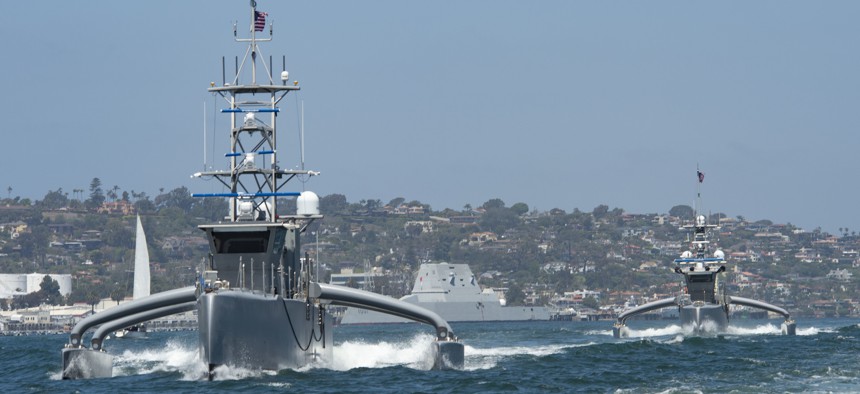
The medium displacement unmanned surface vessels Seahawk, front, and Sea Hunter launched for the U.S. Pacific Fleet’s Unmanned Systems Integrated Battle Problem 21 in April 2021. U.S. Navy / Mass Communication Specialist 2nd Class Thomas Gooley
Navy envisions ‘hundreds of thousands’ of drones in the Pacific to deter China
With DIU contracting for prototypes, Pacific Fleet is experimenting with unmanned craft that may one day defend Taiwan.
SAN DIEGO, California—There’s a reason that the U.S. Navy has been much more open about its experiments with unmanned systems in the Middle East and South America than about the ones it’s conducting in the Pacific.
“And it ain’t because we ain’t doing anything,” Adm. Sam Paparo, the head of U.S. Pacific Fleet, said at the AFCEA West conference here. “We don't want to expose it to an adversary that would emplace a counter to that capability.”
Those experiments are happening, with more taking place soon.
“In the beginning of March, we'll execute Integrated Battle Problem 24.1 that will further demonstrate and test and experiment” with a concept advanced in last year’s edition of the wargame, Paparo said.
He added that the fleet will soon stand up a second USV, or ghost ship, squadron here.
Some of the Defense Innovation Unit’s most recent work on underwater drones is also tied to the INDOPACOM area, said Capt. Alex Campbell, who leads DIU's naval portfolio. DIU recently hired Oceaneering International, Kongsberg Discovery, and Anduril Industries to develop prototypes for sub drones that might one day be produced in the hundreds of thousands.
“So we recently partnered with PEO Attack Submarines, awarded three prototype bodies for a large-diameter UAV. It is meant to be lower cost and is meant to be potentially attributable, and is meant to get after problems that INDOPACOM has,” Campbell said.
DIU is also pursuing a “small uncrewed surface vessel that is functionally meant to be an interceptor—again, relatively low cost, ideally "attritable getting after INDOPACOM problem sets,” he said.
Among the most important of those problems is deterring China from attacking Taiwan, whose Overall Defense Concept sees very large numbers of submarine and surface drones as key to deterring a beach assault. INDOPACOM will seek ways to do that while limiting the numbers of manned vessels and sailors that may have to put themselves between the Chinese Navy and the Taiwanese coast.
Said Paparo: “When the unforgiving hour comes…there are battle spaces where it may not be necessary to contest air and maritime superiority one for one, but simply to deny its use to an enemy that wants to use that battlespace for its own purposes. A principled highly effective concept of operations of sea denial, with unmanned undersea vessels with smart undersea capabilities, with surface capabilities and aerial capabilities is the ability to meet some of the [new] principles, which is: don't send a human being to do something dangerous than a machine can do better, faster, and more cheaply.”
Drones may also be key to INDOPACOM’s Joint Fires Network, a nascent battle-management system designed to find and deliver target data to forces much faster. The system will use AI and likely drones, “utilizing investment automation, and the best technology where it is, in fact, useful. And then of course, leveraging people operating in the loop where it is legally required,” said Justin Norman, DIU’s acting portfolio director/technical director for artificial intelligence and machine learning.
But the Pacific Fleet has some big challenges to work through before it can integrate drones en masse into operations, in large part because putting tens or hundreds of thousands of sea, sub, and air drones into operation presents a logistical challenge that the limited experiments in CENTCOM and SOUTHCOM don’t, said Chris Murphy, the Office of Naval Research’s global science advisor to Pacific Fleet. The sheer number of robots that the fleet is looking at requires that they consider upfront a lot of the problems that usually come later in acquisition.
“Things like concepts of deployment and sustainment. How am I thinking about taking thousands of these things? Am I going to have them sitting on a waterfront, floating in the water, corroding? Or am I going to shrink-wrap them? Do I treat it like a missile that I shrink-wrap and put in a [vertical launch system] tube?” Murphy said. “Or like a RIB on a destroyer that requires an engineer to go out there every day? Those are going to drive design decisions that we don't have time to go back and re-engineer later on.”
While Paparo offered few specifics, he said that the United States and China are already locked in a competition to use new digital tools far faster but also at far greater scale than just a few years ago.
“We are in the middle of another epochal change and that is the dawn–and I do mean the dawn–of the information revolution. Who competes best in this, who adapts better, who is better able to combine data, computing power, AI and who can win the first battle—likely in space, cyber, and the information domain—shall prevail,” he said.
